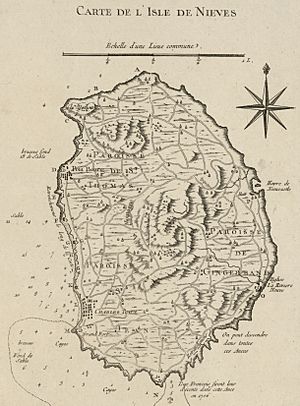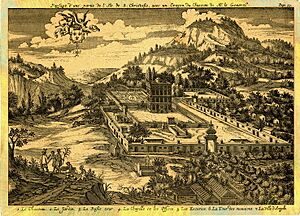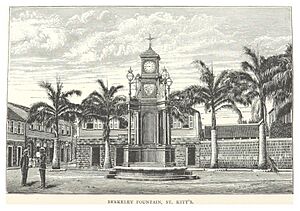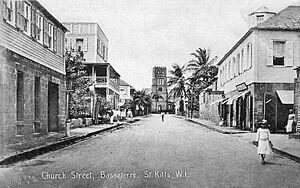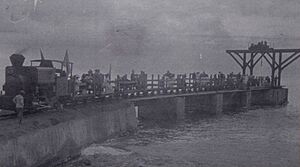History of Saint Kitts and Nevis facts for kids
The islands of Saint Kitts and Nevis have a very long history in the Caribbean. They were among the first places where Spain and England started colonies. Even though they are only two miles apart and quite small, Saint Kitts and Nevis were seen as separate places with their own unique identities. They were only brought together by force in the late 1800s.
Contents
Early History: Before Europeans Arrived (2900 BC – 1493 AD)
The very first people to live on these islands arrived about 3,000 years ago. They were called the Ciboney. We don't know much about where they came from or exactly when they lived because they didn't make pottery. Later, around 800 AD, the Arawak peoples, also known as the Taino, settled on the islands.
After them came the Island Caribs, who were known for being warlike. They had spread north of St. Kitts by the time the Spanish arrived. The largest number of native people lived on the islands between 500 and 600 AD.
First European Visits (1493–1623)
The first Europeans to see and name the islands were led by Christopher Columbus. He spotted the islands on November 11 and 13, 1493, during his second voyage. He named Saint Kitts "San Jorge" (Saint George) and Nevis "San Martin." By 1540, the Spanish were using the name "Nieves" for Nevis. This was a shorter version of "Santa Maria de las Nieves," which referred to the island's cloud cover looking like snow.
An English privateer named Francis Drake mentioned visiting Saint Christophers Island around Christmas in 1585.
The next European visit happened in June 1603. Bartholomew Gilbert collected wood on Nevis before stopping at St. Kitts. In 1607, Captain John Smith stayed on Nevis for five days. He was on his way to start the first successful English settlement in Virginia. Smith wrote about the many hot springs in Nevis. He said their waters could help with skin problems and improve health.
European Settlements and Conflicts (1623–1700)
In 1620, King James I gave Sir Thomas Warner permission to start colonies in the Leeward Islands. Warner arrived on St. Kitts on February 7, 1624, with 15 settlers. He made an agreement with the Carib Chief Ouboutou Tegremante. Three Frenchmen were already on the island. A hurricane in September 1623 destroyed their crops, but the colony still managed to grow.
In 1625, a French captain named Pierre Belain d'Esnambuc arrived on St. Kitts. He had escaped a battle with a Spanish warship. In 1627, Warner and d'Esnambuc divided the island into four parts. The English controlled the middle, and the French controlled the ends. By 1635, there were 500–600 enslaved people on St. Kitts.
As more Europeans arrived, Chief Tegremond became angry in 1626. He planned to get rid of the foreigners with the help of other Island Caribs. However, a native woman told Warner and d'Esnambuc about the plan. They decided to act first, killing 120 Caribs in their sleep. The next day, at a place now called Bloody Point, over 2,000 Caribs were killed. By 1640, the remaining Caribs who were not enslaved on St. Kitts, Nevis, and Antigua were moved to Dominica.
In 1628, Warner allowed Anthony Hilton and 80 others from St. Kitts to settle Nevis. Hilton had decided to sell his St. Kitts plantation after escaping an attack by his servant.
Both the English and French then started to colonize nearby islands from their bases. The English settled Nevis (1628), Antigua (1632), and Montserrat (1632). The French colonized Martinique (1635) and Guadeloupe (1635).
Saint Kitts and Nevis suffered greatly from a Spanish attack in 1629. All settlements were destroyed, and many people were taken away. This was the only time Spain tried to keep the English and French out of the Leeward Islands.
The islands' first main crop was tobacco. But too much tobacco was grown in the Caribbean and North America, which made prices drop. This led to a pause in tobacco farming on St. Kitts in 1639. So, people started growing sugar cane to make sugar. Sugar production began on St. Kitts in 1643 and on Nevis in 1648. Windmills were built to crush the cane. The planters became very rich. By 1652, Nevis was the richest British colony in the Western Hemisphere.
Growing sugar required many workers. Since many indentured servants did not survive, African slaves were brought to the islands. By the end of the 17th century, there were twice as many enslaved people as Europeans on St. Kitts. The enslaved people faced very harsh living and working conditions. Many died within a year of arriving.
After d'Esnambuc died in 1635, Phillippe de Longvilliers de Poincy became the leader of the French islands. The King of France had sold the French part of the island to the Order of Saint John. De Poincy began building his Château de la Montagne in 1642.
During the Second Anglo-Dutch War, the English and French settlers on the island started fighting because their home countries were at war. In April 1666, French Governor Charles de Sales attacked the English side. He was killed, and the French took control of St. Kitts. The French then tried to take Nevis but were stopped by the English. The Treaty of Breda later returned things to how they were before the war.
In 1689, during the War of the Grand Alliance, the French attacked the English side of St. Kitts again. The English were forced to surrender and were sent to Nevis. In 1690, the English, led by Sir Christopher Codrington, landed on St. Kitts and took it back. The French were sent away. After this, the British began building the Brimstone Hill Fortress. The Treaty of Rijswijk in 1697 restored the previous situation.
In 1690, a huge earthquake and tsunami destroyed Jamestown, which was the capital of Nevis at the time. The city was completely abandoned. The capital was then moved south to Charlestown.
Struggles and Changes (1700–1883)
Saint Kitts and Nevis faced more destruction during the War of the Spanish Succession. In 1702, the French governor of St. Kitts surrendered the island to the English. The French residents were moved to other islands. The French fought back in 1705, attacking Nevis and St. Kitts. They stole many enslaved people and burned down Charlestown. Nevis was left in ruins. The Treaty of Utrecht was signed in 1713, and the French gave their part of St. Kitts to the British.
By 1720, the population of St. Kitts was larger than Nevis for the first time. In 1727, the British moved the capital of St. Kitts to Basseterre. St. Kitts quickly became a leader in sugar production. Meanwhile, Nevis saw a decline. Years of growing only one crop and soil erosion caused its sugar production to drop.
Alexander Hamilton, who became the first Secretary of the Treasury in the United States, was born in Nevis. He spent his childhood there and on St. Croix.
In 1778, John Huggins built the first resort hotel in the Caribbean, called the Bath Hotel. It was built over one of the island's famous hot springs. This made Nevis the first place in the Americas to officially have tourism. The hotel was popular with the British upper classes for many years.
By 1776, Saint Kitts was the richest British colony in the Caribbean for each person living there. The French attacked the islands several times in the late 1700s, including the Siege of Brimstone Hill in 1782. British rule was finally recognized under the Treaty of Versailles in 1783.
On March 11, 1787, Captain Nelson married Frances Woolward Nisbet at Montpelier Plantation in Nevis. Prince William Henry was his best man.
The trade of enslaved Africans was stopped in the British Empire in 1807. Slavery itself was made illegal in 1834. After this, enslaved people had a four-year "apprenticeship" period where they worked for their former owners for wages. On Nevis, 8,815 enslaved people were freed, and on St. Kitts, 19,780 were freed.
A hurricane in 1835, followed by a drought and a fire, badly damaged Nevis. Sugar prices continued to fall, and by 1842, Nevis's population declined as workers left the island. St. Kitts's soil was not as affected. Then, several earthquakes struck in 1843, followed by a cholera epidemic in 1853–54, which killed many people on both islands.
In 1872, St. Kitts was connected to the international telegraph system. Nevis did not get this connection until 1925.
In 1883, the governments of St. Kitts, Nevis, and Anguilla were combined into the St. Kitts Assembly. Nevis had two seats in this assembly, and Anguilla had one.
Modern History: From Federation to Independence (1883 – present)
The production of beet sugar in other parts of the world made sugar prices drop, which put pressure on wages on the islands. This led to riots in 1896. By 1900, Nevis had 61 estates using a sharecropping system, while St. Kitts had only 2.
The 1899 San Ciriaco hurricane caused much damage. It left 27 people dead on Nevis and destroyed the Nevis hospital, leaving 8,000 people homeless.
In 1912, the St. Kitts Sugar Producers Association built a central factory for refining sugar and a railway for transportation. A telephone system was built on St. Kitts in 1896 and included Nevis by 1913. Nevis's first car arrived in 1912.
During World War I, cotton production helped the economy, but it declined after 1922. The Great Depression meant that the government became the largest landowner on Nevis as estates were abandoned.
In 1951, the islands were given the right to vote, and the first election was held in 1952.
Sugar production continued to be very important. The land was mostly owned by estate owners, which limited other types of development. This led to many workers feeling unhappy with foreign influence. The drop in sugar prices during the Great Depression led to the start of organized labor movements. The Workers League was formed in 1932. It later became the St. Kitts and Nevis Trades and Labour Union in 1940, led by Robert Llewellyn Bradshaw. This union created a political party, the St. Kitts and Nevis Labour Party, which dominated politics for over thirty years.
Electricity first came to Nevis in 1954.
The islands were part of the Leeward Islands Federation until they joined the West Indies Federation from 1958 to 1962. Saint Christopher-Nevis-Anguilla was a separate state within this federation. Robert Bradshaw was the Minister of Finance.
In 1967, the islands became an Associated State of Britain. In the same year, Anguilla tried to break away from the union. Anguilla successfully separated in 1971.
In 1970, there was a serious boat accident, the Christena disaster, where an overloaded ferry sank, and many lives were lost.
During Bradshaw's time as leader, his government started taking more control of the economy in 1972. All sugar lands were bought by the government, and the sugar factory was nationalized in 1976.
People started to oppose Bradshaw's rule, especially former estate owners who formed the People's Action Movement (PAM) party in 1964. Opposition was strong in Nevis, where people felt their island was being ignored and unfairly treated by St. Kitts.
In 1978, Bradshaw died. His deputy, Paul Southwell, took over, but he also died in 1979. This caused a leadership crisis in the Labour Party.
The PAM party did very well in the 1980 elections, winning three seats on St. Kitts. The Nevis Reformation Party, led by Simeon Daniel, won two seats on Nevis. PAM and NRP formed a coalition government, and Kennedy Simmonds, a doctor and one of PAM's founders, became premier. This change in government reduced the demand for Nevis to separate.
Independence Since 1983
In 1983, the federation became independent from Britain. The new constitution gave Nevis a lot of self-rule and the right to separate if it wanted to. In the 1984 elections, the NRP won all three seats on Nevis, and PAM won six seats on St. Kitts. The new coalition government had a strong majority.
The economy of St. Kitts improved as the PAM party focused on tourism instead of the sugar industry. However, many of the poorest people, especially sugar workers, felt left out. Opposition to PAM grew, along with accusations of corruption. In the 1993 elections, both PAM and Labour won four seats each. On Nevis, a new party, the Concerned Citizens Movement, won two seats. This led to a political deadlock. Riots followed, which were resolved by special elections in 1995. The Labour Party won by a large margin, and Dr. Denzil Douglas became the new prime minister.
On September 21, 1998, Hurricane Georges caused severe damage to the islands, costing nearly $500 million. It was the worst hurricane to hit the region in the 20th century.
In 2005, the Douglas government closed the sugar industry on St. Kitts after 365 years. This was because the industry was losing a lot of money and facing threats from the European Union to cut sugar prices. Since then, tourism has become the main focus of the economy.
The 2015 Saint Kitts and Nevis general election was won by Timothy Harris and his new People's Labour Party. They formed a coalition called 'Team Unity' with PAM and the Nevis-based Concerned Citizens' Movement.
In June 2020, the Team Unity coalition, led by Prime Minister Timothy Harris, won the general elections.
In the general election on August 5, 2022, Terrance Drew was elected as the fourth prime minister of Saint Kitts and Nevis. His St. Kitts-Nevis Labour Party (SKNLP) won the snap general election.
Images for kids
-
Hon Stedman Rawlins, d. 1830, Slave/ Plantation Owner, Saint Kitts, Old Burying Ground (Halifax, Nova Scotia).
See also
 In Spanish: Historia de San Cristóbal y Nieves para niños
In Spanish: Historia de San Cristóbal y Nieves para niños
- British colonization of the Americas
- French colonization of the Americas
- French settlement in Saint Kitts and Nevis
- History of North America
- History of the Americas
- History of the British West Indies
- History of the Caribbean
- List of colonial governors and administrators of Nevis
- List of colonial governors and administrators of Saint Christopher
- List of governors of the Leeward Islands
- List of prime ministers of Saint Kitts and Nevis
- Politics of Saint Kitts and Nevis
- Spanish colonization of the Americas
- Eden Brown Estate
- Cyril Briggs
- John Burdon



